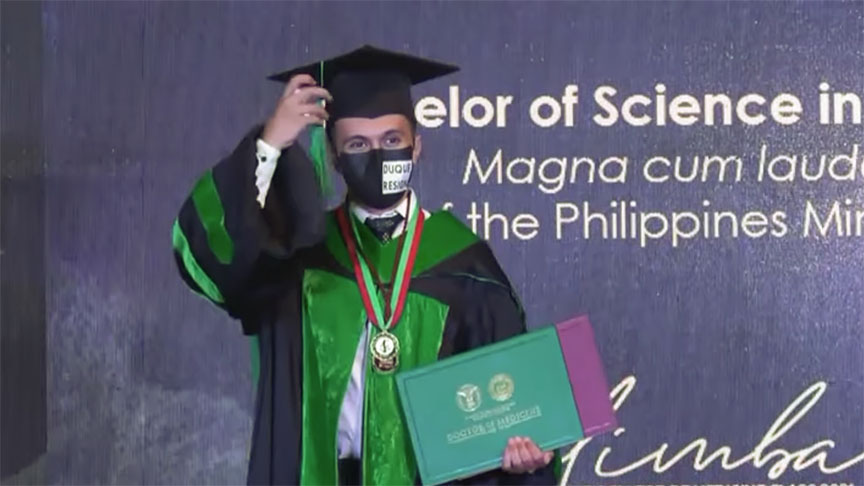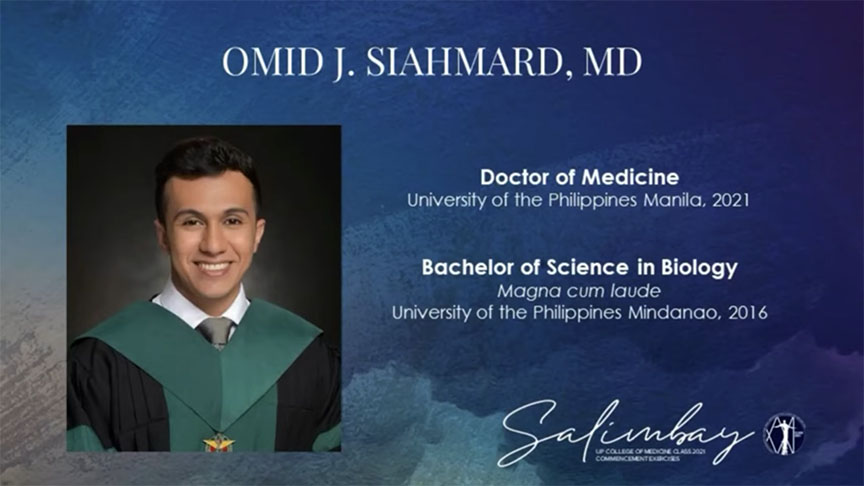DAVAO CITY (MindaNews / 13 Aug) – A fresh graduate from the University of the Philippines College of Medicine in Manila, whose commencement speech as representative of Class 2021 went viral online, aims to pursue a medical practice in his hometown in North Cotabato once he finishes with his board exams.
 Dr. Omid Siahmard during the UPCM Class 2021 commencement exercises. Screengrab from the UPCM 2021 Youtube Page
Dr. Omid Siahmard during the UPCM Class 2021 commencement exercises. Screengrab from the UPCM 2021 Youtube Page
Dr. Omid Javier Siahmard, 25, plans to come back to the municipality of M’lang after he tackles the licensure examination by next year.
Siahmard’s speech has reached more than 42,000 views, 4,000 likes and 2,000 shares on Facebook as of this writing. [Read full text here.]
The doctor said he wished to contribute to the filling up of the shortage of primary healthcare workers in provinces in the Philippines, something he saw firsthand as an intern at the Philippine General Hospital (PGH).
People went to the PGH, he said, as access to primary facilities were hard to come by or too expensive.
In an interview with MindaNews, Siahmard said that his personal interactions with patients, people around the hospital, hospital companions, and other kinds of everyday people affected him deeply, pointing out that the strongest people inside the hospitals were the patients’ companions, more commonly known as “bantay” or “watcher.”
“There’s a different kind of strength that you see in the patient’s companions,” the doctor said.
“Yung strength nila na maghatid pa lang sa pasyente, maghintay sa triage. Minsan sila pa ang nauutusan magpasa ng dugo at magbayad ng mga bills,” Siahmard said.
If the patient has a chronic condition, the watchers have no choice but to stay in the hospital for months at a time.
“Yung patient experience sa loob ng hospital, hindi siya biro,” he said. “It’s a clear picture of suffering.”
“We can easily understand the Philippine healthcare system if we try to look deeper into the everyday people we see on the streets,” Siahmard said.
One patient, he recalled, spent the last of his money riding the jeep to the hospital.
He once had to hold back tears when a father of one patient said if it was possible to borrow a suction tube somewhere, since they could not afford to buy one. “Kailangan po ba talaga ito, dok? Walang wala na po kaming pera,” Siahmard was told.
The tube cost less than P100, and this was one of many instances when he could see how difficult life was for patients relying on the government hospital.
In some cases, the doctors themselves would be tempted to pull out their own wallets to help the patient, but Omid admits this doesn’t really solve anything in the long run.
“The hospital experience is paralyzing,” he said.
People who have to take their patients to hospitals need to stop working, and thus don’t earn every day of their absence, he pointed out. Their children won’t get to receive a daily allowance, if any.
Commencement speeches usually begin with the difficulties of med school, the thankfulness of students for support, and a few quotes here and there.
Omid’s speech started with an image of a med student, Omid himself, recalling a time when he was buying street food outside the PGH. The vendor and his wife got nervous when a police mobile parked nearby, hinting a possibility of a clearing operation at the sidewalks along the hospital.
“An ordinance allowed authorities to clear sidewalks from vendors and beggars as if they were merely an obstruction along the busy streets of Manila. Kuya did not move a muscle, and his wife looked uneasy. Luckily, without any word from the police, they restarted the mobile within minutes, slowly drove by a mall owned by a multi-millionaire, and left.”

The speech eventually zoomed out into the hardships that patients face, aside from the larger national problem of the healthcare sector, and how he was among those who protested against injustice he perceived even as he was studying to be a doctor.
“Kailangan sila yung center ng vocation natin. Sila yung center ng mga advocacies natin. Yung mga nag-eensure na mag survive ang society, kasi sila din yung api,” he said, referring to frontliners such as sidewalk vendors, security guards, mall cashiers.
Back home, the Department of Health’s Center for Health Development Region XII lists down four provincial health offices, five city health offices, two retained hospitals, 29 government hospitals, 94 private hospitals, 6,303 hospital beds, 61 main health centers, and around 1,136 barangay health stations.
These figures come from the DOH’s Field Health Services Information System 2020 Annual Report.
The provincial health offices cater to a ratio of one center to 1.22 million residents for the entire region.
There are 149 doctors employed by government as of 2020 – serving in public hospitals and other government health offices – catering to a ratio of 1 physician for every 33,020 residents.
The doctors in Region XII are supported by 1,185 nurses, 1,225 midwives, 88 sanitation inspectors, 1 sanitary engineer, 54 dentists, 50 nutritionists, 173 medical technologists, and 8,536 barangay health workers.
But Siahmard will be taking a well-deserved time off, having decided to take a pause after a life saturated in education. He graduated magna cum laude at the University of the Philippines Mindanao before pursuing his MD at UP’s College of Medicine.
He and a few friends have decided to skip the upcoming board exams, opting instead to take next year’s April slots. (Yas D. Ocampo / MindaNews)
